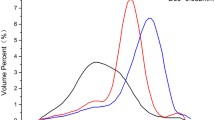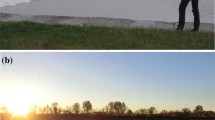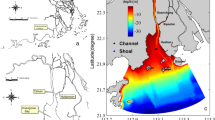Abstract
A tidal bore is a hydrodynamic discontinuity propagating upstream in an estuarine zone with a funnel shape as the tide starts rising under spring tidal conditions. The transient sediment motion beneath tidal bores was investigated in laboratory under controlled flow conditions by measuring simultaneously the fluid and sediment particle velocities. Although no sediment transport was observed in the initially steady flow and in undular bores, a transient sheet flow motion was observed beneath the breaking bores. The sediment transport was initiated during the passage of the bore roller toe by the large longitudinal pressure gradient force, and the sediment particles were subjected to large horizontal accelerations. About 5 % of all particles were accelerated in excess of 1 g. The sediments were advected upstream with an average velocity close to the instantaneous fluid velocity. The time evolution of instantaneous particle velocity for each trajectory was analysed, using the starting point of particle trajectory corresponding to the entrainment point, and the end point to the particle stoppage point. The present data provided some quantitative data in terms of force terms acting on sediment particles beneath a tidal bore and their trajectory characteristics.










Similar content being viewed by others
References
Azimi AH, Zhu DZ, Rajaratnam N (2012) Computational investigation of vertical slurry jets in water. Int J Multiph Flow 47:94–114
Brocchini M (2013) Bore-generated macrovortices on erodible beds. J Fluid Mech 734:486–508
Calzavarini E, van der Berg TH, Toschi F, Lohse D (2008) Quantifying microbubble clustering in turbulent flow from single-point measurements. Phys Fluids 20(4):040702. doi:10.1063/1.2911036
Chachereau Y, Chanson H (2011) Free surface fluctuations and turbulence in hydraulic jumps. Exp Thermal Fluid Sci 35(6):896–909. doi:10.1016/j.expthermflusci.2011.01.009
Chanson H (2011) Tidal Bores, Aegir, Eagre, Mascaret, Pororoca: theory and observations. World Scientific, Singapore
Chanson H (2012) Momentum considerations in hydraulic jumps and bores. J Irrig Drain Eng ASCE 138(4):382–385. doi:10.1061/(ASCE)IR.1943-4774.0000409
Chanson H, Lubin P (2013) Mixing and sediment processes induced by Tsunamis propagating upriver in Tsunamis: economic impact, disaster management and future challenges. Nova Science Publishers, Hauppauge NY, USA, T Cai (ed), Chapter 3, pp 65–102
Chanson H, Reungoat D, Simon B, Lubin P (2011) High-frequency turbulence and suspended sediment concentration measurements in the Garonne River Tidal Bore. Estuar Coast Shelf Sci 95(2–3):298–306. doi:10.1016/j.ecss.2011.09.012
Chen J, Liu C, Zhang Ch, Walker HJ (1990) Geomorphological development and sedimentation in Qiantang Estuary and Hangzhou Bay. J Coast Res 6(3):559–572
Favre H (1935) Etude Théorique et Expérimentale des Ondes de Translation dans les Canaux Découverts. (’Theoretical and Experimental Study of Travelling Surges in Open Channels’.) Dunod, Paris, France (in French)
Greb SF, Archer AW (2007) Soft-sediment deformation produced by Tides in a Meizoseismic Area, Turnagain Arm, Alaska. Geology 35(5):435–438
Hoyt JW, Sellin RHJ (1989) Hydraulic jump as ’mixing layer’. J Hydraul Eng ASCE 115(12):1607–1614
Jang JH, Ho H-Y, Yen C-L (2011) Effects of lifting force on bed topography and bed-surface sediment size in channel bend. J Hydraul Eng ASCE 137(9):911–920. doi:10.1061/(ASCE)HY.1943-7900.0000402
Khezri N (2014) Modelling turbulent mixing and sediment process beneath Tidal Bores: physical and numerical investigations. Ph.D. thesis, School of Civil Engineering, The University of Queensland, Brisbane, Australia
Khezri N, Chanson H (2012) Undular and breaking tidal bores on fixed and movable gravel beds. J Hydraul Res IAHR 50(4):353–363. doi:10.1080/00221686.2012.686200
Khezri N, Chanson H (2012) Inception of bed load motion beneath a bore. Geomorphology, vol 153–154, pp 39–47 and 2 video movies. doi:10.1016/j.geomorph.2012.02.006
Koch C, Chanson H (2008) Turbulent mixing beneath an undular bore front. J Coast Res 24(4):999–1007. doi:10.2112/06-0688.1
Lacasce JH, Bower A (2000) Relative dispersion in the subsurface North Atlantic. J Mar Res 58:863–894
Lacasce JH, Ohlmann C (2003) Relative dispersion at the surface of the Gulf of Mexico. J Mar Res 61:285–312
Liggett JA (1994) Fluid Mechanics. McGraw-Hill, New York, USA
Lighthill J (1978) Waves in fluids. Cambridge University Press, Cambridge
Mattioli M, Alsina JM, Mancinelli A, Miozzi M, Brocchini M (2012) Experimental investigation of the nearbed dynamics around a submarine pipeline laying in different types of seabed: the interaction between turbulent structures and particles. Adv Water Resour 48:31–46
Mei R (1992) Approximate expression for the shear lift force on a spherical particle at finite Reynolds number. Int J Multiph Flow 18(1):145–147
Misra SK, Kirby JT, Brocchini M, Veron F, Thomas M, Kambhamettu C (2008) The mean and turbulent flow structure of a weak hydraulic jump. Phys Fluids 20(3), Paper 035106
Montes JS, Chanson H (1998) Characteristics of undular hydraulic jumps. Results and calculations. J Hydraul Eng ASCE 124(2):192–205
Morel P, Larcheveque M (1974) Relative dispersion of constant-level balloons in the 200-mb general circulation. J Atmos Sci 31:2189–2196
Mouaze D, Chanson H, Simon B (2010) Field measurements in the Tidal Bore of the Sélune River in the Bay of Mont Saint Michel (September 2010). Hydraulic model report no. CH81/10, School of Civil Engineering, The University of Queensland, Brisbane, Australia
Nikora V, Head J, Goring D, McEwan I (2001) Diffusion of saltating particles in unidirectional water flow over a rough granular bed. J Phys A Math General 34:L743–L749. doi:10.1088/0305-4470/34/50/103
Nikora V, Habersack H, Huber T, McEwan I (2002) On bed particle diffusion in gravel bed flows under weak bed load. Water Resour Res vol 38, no. 6, Paper 1081. doi:10.1029/2001WR000513
Peregrine DH (1966) Calculations of the development of an undular bore. J Fluid Mech 25:321–330
Piattella A, Brocchini M, Mancinelli A (2006) Topographically controlled, breaking-wave-induced macrovortices. Part 3. The mixing features. J Fluid Mech 559:81–106
Reungoat D, Chanson H, Caplain B (2014) Sediment processes and flow reversal in the undular Tidal Bore of the Garonne River (France). Environ Fluid Mech, vol 20. doi:10.1007/s10652-013-9319-y. (Online first)
Tanaka N, Yagisawa J, Yasuda S (2012) Characteristics of damage due to Tsunami propagation in River channels and overflow of their embankments in Great East Japan earthquake. Int J River Basin Manag 10(3):269–279
Tessier B, Terwindt JHJ (1994) An example of soft-sediment deformations in an intertidal environment—the effect of a Tidal Bore. Comptes-Rendus de l’Académie des Sciences, Série II, vol 319, no. 2. Part 2, pp 217–233 (in French)
Treske A (1994) Undular bores (favre-waves) in open channels—experimental studies. J Hydraul Res IAHR 32(3):355–370
Tricker RAR (1965) Bores, breakers, waves and wakes. American Elsevier, New York
Acknowledgments
The authors thank an anonymous reviewer as well as Dr Pierre Lubin (University of Bordeaux, France) for their helpful comments and advice. They acknowledge the technical assistance of Graham Illidge, Ahmed Ibrahim and Jason Van Der Gevel (The University of Queensland), and the financial support of the University of Queensland and Agence Nationale de la Recherche (Project MASCARET 10-BLAN-0911-01).
Author information
Authors and Affiliations
Corresponding author
Rights and permissions
About this article
Cite this article
Khzeri, N., Chanson, H. Turbulent velocity, sediment motion and particle trajectories under breaking tidal bores: simultaneous physical measurements. Environ Fluid Mech 15, 633–650 (2015). https://doi.org/10.1007/s10652-014-9358-z
Received:
Accepted:
Published:
Issue Date:
DOI: https://doi.org/10.1007/s10652-014-9358-z




